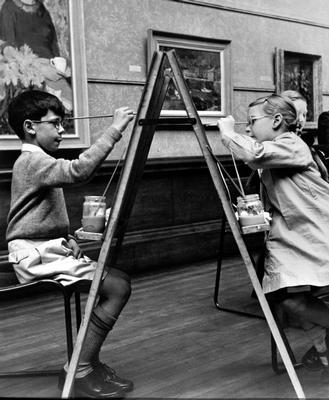 A recurring problem with stories about lawsuits is that only one side of the story is presented. Due to understandable hesitations, the party that is being sued is unlikely to comment on the lawsuit until they are able to formally respond to the lawsuit. You generally don't win lawsuits on the news pages.
This dilemma is prefectly illustrated in this Associated Press report out of Madison on an anonymous student's lawsuit against his school district after his art teacher told him it violated school policy because his drawing included the words "John 3:16 A sign of peace." The teacher allegedly told the student that his constitutional rights were signed away at the start of the semester:
A recurring problem with stories about lawsuits is that only one side of the story is presented. Due to understandable hesitations, the party that is being sued is unlikely to comment on the lawsuit until they are able to formally respond to the lawsuit. You generally don't win lawsuits on the news pages.
This dilemma is prefectly illustrated in this Associated Press report out of Madison on an anonymous student's lawsuit against his school district after his art teacher told him it violated school policy because his drawing included the words "John 3:16 A sign of peace." The teacher allegedly told the student that his constitutional rights were signed away at the start of the semester:
The lawsuit alleges other students were allowed to draw "demonic" images and asks a judge to declare a class policy prohibiting religion in art unconstitutional.
"We hear so much today about tolerance," said David Cortman, an attorney with the Alliance Defense Fund, a Christian legal advocacy group representing the student. "But where is the tolerance for religious beliefs? The whole purpose of art is to reflect your own personal experience. To tell a student his religious beliefs can legally be censored sends the wrong message."
Tomah School District Business Manager Greg Gaarder said the district hadn't seen the lawsuit and declined to comment.
A benefit of relying on papers filed in a lawsuit is that the facts are all probably true. Attorneys stating inaccurate facts in papers filed with a federal court face stiff penalties if they were in anyway negligent in failing to determine their truthiness.
However, what will go unpunished and is even encouraged is the deliberate slanting and careful selection of facts that are intended to put the client in the most favorable light possible. That does not mean the facts should not be used, reporters should just be careful in portraying situations based solely on such documents. There is likely more to the story.
The story also neglects to refer to any controlling legal authority that could give the reader a sense for whether the student in this story has a chance of success. There may not be a clear answer, but if that were the case, we may have a Supreme Court case on our hands. Some quality analysis of the legal cause would be most helpful.
Lastly, the story cites the student in the story by his initials A.P. While this technique is common in legal practice, should it be in journalism? In other words, should a journalist allow the subject of their story to hide behind a cloak of anonymity while the rest of the characters in the story, usually portrayed as the villains, get to have their names in the newspaper?
